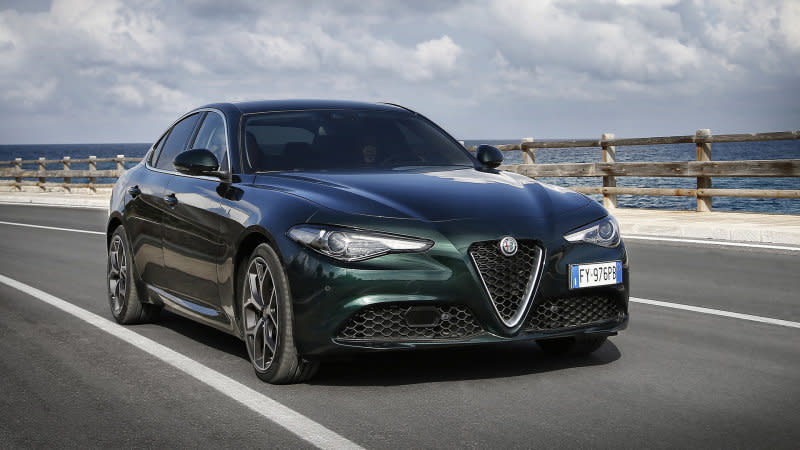2020 Alfa Romeo Giulia Review & Buying Guide | Same dish, better noodles
When it comes to Italian cooking, the noodles matter less than the sauce. Despite the Alfa Romeo Guilia's robust flavor, especially the arrabiata 505-horsepower Quadrifoglio, there was no disputing the fact that the pasta upon which that delightful gravy was slathered came out a bit under-done. It was beautiful and wildly fun to drive, but it also seemed a bit incomplete due to a dated and relatively cheap-feeling cabin. There were also pervasive, widely reported reliability issues.
To address the criticisms and improve the pasta, so to speak, the 2020 Alfa Romeo Giulia sees a multitude of updates intended to make it more competitive against its mainly German competitors. These are best noticed in the upgraded switchgear and more modern infotainment features. The driver assistance tech gets a successful upgrade as well. Now, only time will tell regarding the reliability issues, but after some time spent with a 2020 Giulia, we can at least report that it's far closer to the sexy Italian sedan we should have gotten from day one.
What's new for 2020?
You’d be hard-pressed to tell the difference from looking at it, but the 2020 Giulia received a lot of upgrades. Alfa upgraded the sedan’s interior materials and added a ton of new technology, including an available Wi-Fi hotspot, over-the-air software updates, and both wireless and USB Type-C device charging capabilities. As an added bonus, the 8.8-inch infotainment screen is now standard and has been upgraded to a touch display, while the driver assistance tech has been upgraded with new systems supplied by Bosch.



What's the Giulia’s interior and in-car technology like?
Alfa’s 2020 upgrades focused on improving the Giulia’s cabin, and it’s much better for it. Materials on the steering wheel, dash and center console were all improved and the control interfaces made less flimsy and toy-like. The overall quality result still doesn't match most competitors, but it's no longer objectionable and the materials generally feel nice to the touch.
The design itself stays basically the same, maintaining its attractive and minimalist look. It lacks the Swedish flair of a Volvo S60 or the drama of some of the offerings available from Lexus and Mercedes, but Alfa was sure to pack in just enough Italian flair to keep things interesting. There's even a little Italian tricolore emblem at the base of the shifter.
The Giulia has a standard 7-inch full-color gauge cluster display and 8.8-inch touchscreen infotainment system. A navigation system and Wi-Fi hotspot can both be added, and the latter enables over-the-air updates and a companion app for both Android and iOS. All Giulia models come with USB charging ports for both the front and rear of the cabin.
Despite the improvements for 2020, the Giulia’s interior still trails its competitors in terms of comfort and convenience features. The front sport bucket seats are comfortable and supportive but lack the finer adjustment of those offered by competitors. More indulgent niceties, such as the massaging seats offered by Mercedes-Benz, Audi and Volvo, are nowhere to be found in Alfa’s sport sedan.
How big is the Giulia?
The Giulia is a compact European sedan, like the BMW 3 Series, Audi A4 or Mercedes-Benz C-Class. Its interior is a bit on the cramped side even for this segment, but it will seat four adults (five in a pinch). Front-seat space is more than adequate, and the Giulia’s driving position is excellent, but at the expense of back-seat room. Legroom is at a premium, especially behind taller drivers and front-seat passenger. The trunk, likewise, is on the smaller side for the class at 13 cubic-feet.
Those who regularly need more passenger and cargo room would be better served by the Alfa Romeo Stelvio crossover, which is available with the same powertrains offered in the Giulia.
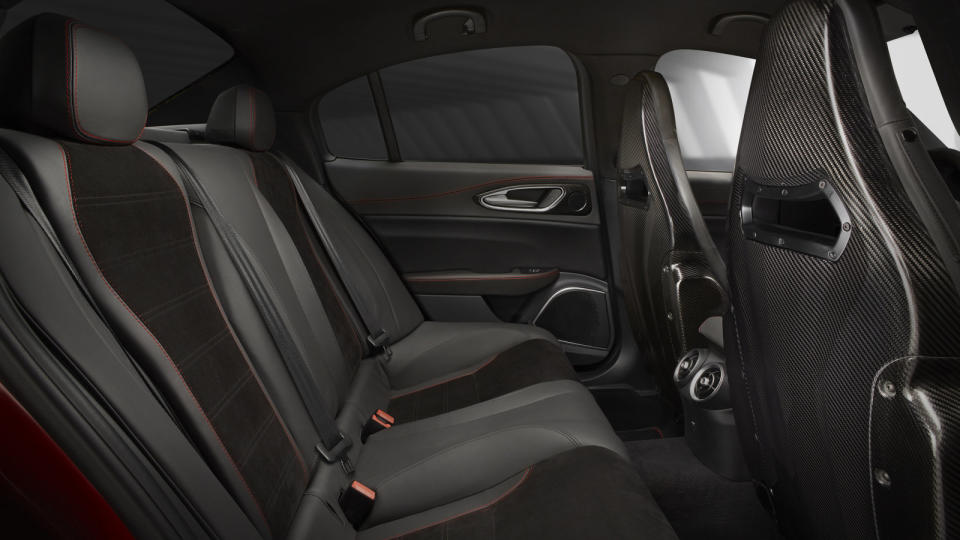
What's the performance and fuel economy?
The standard Giulia is offered exclusively with a 2.0-liter turbocharged engine producing a class-leading 280 horsepower and 306 pound-feet of torque, paired to an eight-speed automatic transmission. Rear-wheel drive is standard on all Giulia and Giulia Ti models, but all-wheel drive is available across the lineup for $2,000 more.
Rear-wheel drive models will do 0-60 in 5.5 seconds; all-wheel drive drops that time to just 5.1 seconds. Fuel economy is rated at 24 mpg city, 33 mpg highway and 27 mpg combined with rear-wheel drive; all-wheel drive drops those figures to 23 mpg city, 31 highway and 26 combined.
The high-performance Quadrifoglio boasts 505 horsepower and 443 lb-ft of torque from a twin-turbocharged, 2.9-liter V6. The Quadrifoglio competes with the likes of the BMW M4, Audi RS4 and Mercedes-AMG C63 and is offered only with rear-wheel drive and an eight-speed automatic. Alfa says it will do 0-60 in 3.8 seconds on the way to a 191-mph top speed. The Quadrifoglio fuel economy is 17/25/20, respectively.



What's the Giulia like to drive?
While the Giulia’s interior may be a bit low-rent compared to some of the established competition, it more than makes up for those shortcomings with incredible driving dynamics and, in the case of the Quadrifoglio, an intoxicating and responsive powertrain.
Even the base Giulia is offered with an enthusiast-friendly sport suspension, and while its four-cylinder engine may not hold a candle to the 505-horsepower V6 in the Quadrifoglio, it makes more than enough power for daily driving and even a little weekend corner-carving. The Giulia feels light and playful, with a stiff chassis and adeptly tuned suspension.
While competitors such as the BMW 3 Series may be losing their edge, the Giulia puts driver engagement first. At the same time, the adaptive dampers available in the Ti trim's Performance package impressively sops up nasty bumps. Cars with such a sporting "edge" are often given a pass when it comes to ride quality, as a sore back and kidneys bruised by the seat bolsters are considered par for the course. The Giulia needs no such handicap.
What more can I read about the Alfa Romeo Giulia?
2020 Alfa Romeo Giulia First Drive | All about the little things
Subtle but successful changes were made to the interior, infotainment and safety features.
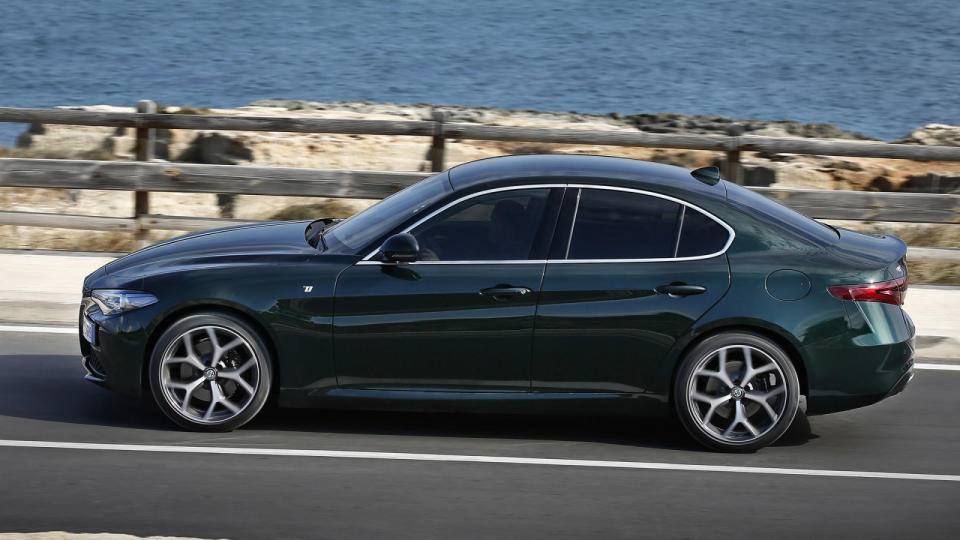
The 2020 Alfa Romeo Giulia's infotainment system is new, but is it better?
Byron puts the updated 8.8-inch touchscreen infotainment system through its paces in this walkthrough.

2017 Alfa Romeo Giulia Ti Lusso Drivers' Notes | We've got a crush on Giulia
Exotic, enigmatic, luxurious and dressed in black.
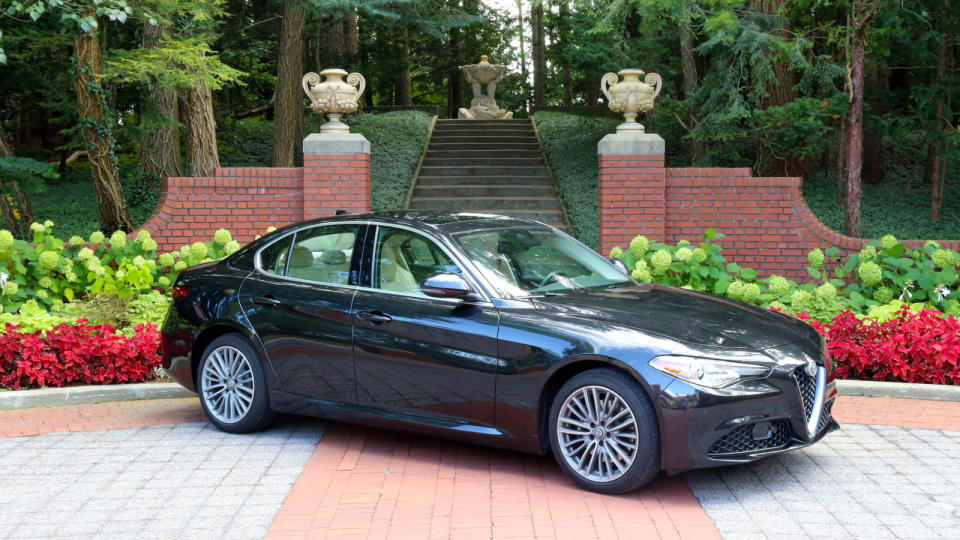
Porsche 911 Carrera 4, Alfa Romeo Giulia Quadrifoglio and a chat with Jean Jennings | Autoblog Podcast #626
Plus VW Tiguan R-Line and the latest Toyota Supra news
Alfa Romeo's Giulia Quadrifoglio gets the GTA treatment
A limited-production, 540-horsepower track car from Alfa? Yes, please.
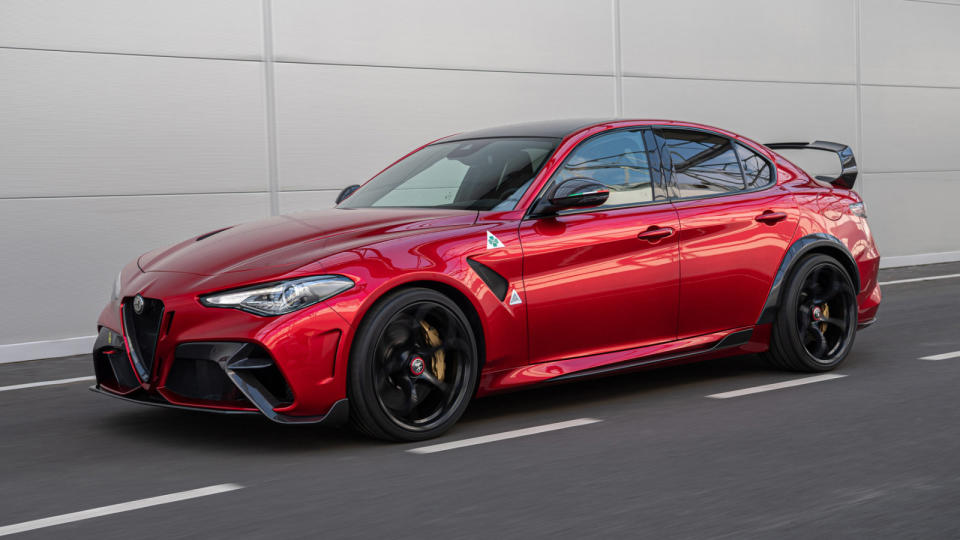
What features are available and what's the price?
The 2020 Alfa Romeo Giulia starts at $40,695 (including a $1,295 destination fee) and is nicely equipped even in base form. Standard features include 17-inch wheels, dual-zone climate control, power-adjustable front seats with leather upholstery, remote start, the aforementioned 8.8-inch touchscreen infotainment system with 8 speakers and Android Auto/Apple CarPlay integration.
Sport models add dark-finish wheels and other sporty trim elements; the Sport interior package adds paddle shifters along with other unique trim. The Lusso (Italian for “Luxury”) adds an upgraded steering wheel, walnut or Oak trim, and leather on the dash and door panels. The Ti Sport Carbon gets visual upgrades inspired by the Quadrifoglio, including clover-shaped, 19-inch wheels and, as the name suggests, a bunch of carbon fiber.
The Quadrifoglio model is effectively loaded, but certain elements, such as a carbon fiber steering wheel and carbon fiber exterior upgrades, are only available as add-ons.
Below is the full pricing structure for the 2020 Alfa Romeo Giulia. You can find a full breakdown of features, specs and local pricing here on Autoblog.
Giulia: $40,695
Giulia Sport: $42,145
Giulia Ti: $42,695
Giulia Ti Lusso: $45,195
Giulia Ti Sport: $45,695
Giulia Ti Sport Carbon: $49,695
Giulia Quadrifoglio: $75,795
What are its safety equipment and crash ratings?
In addition to basic, required features such as a rearview camera and airbags, the Giulia also has forward collision warning, rear parking sensors, LED daytime running lights and hill start assist as standard equipment.
The Driver Assistance Dynamic Package, which is available on all trims, adds adaptive cruise control with full-stop capability, automatic high beams and lane-departure warning. The Giulia’s adaptive cruise control system is well-executed and flexible, relieving stress on longer drives. We found the lane keeping assist can be frustrating at times, fighting back against merges even when the turn signal is activated, but the system is passable overall. Blind-spot monitoring and front parking sensors are also available as part of a separate package.
The Giulia has not yet been tested by the U.S. government, but the Insurance Institute for Highway Safety rated it “Good” in all of its crashworthiness tests. Its collision avoidance technology was rated “Superior” as well, but its base-model headlights were rated “Poor” even with the automatic high-beam option included in the Driver Assistance Dynamic Package. The headlights available in the High Performance Bi-Xenon package were rated “Good” and are available on Ti models and standard on the Quadrifoglio.
Related Video
You Might Also Like




